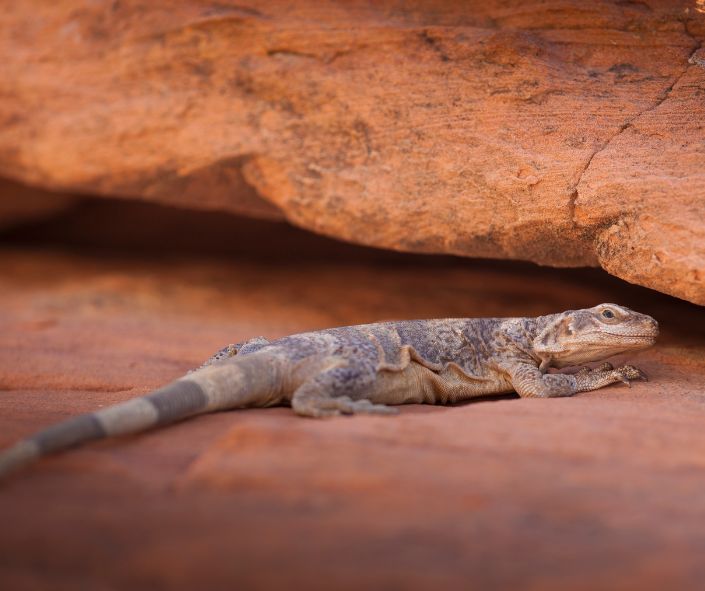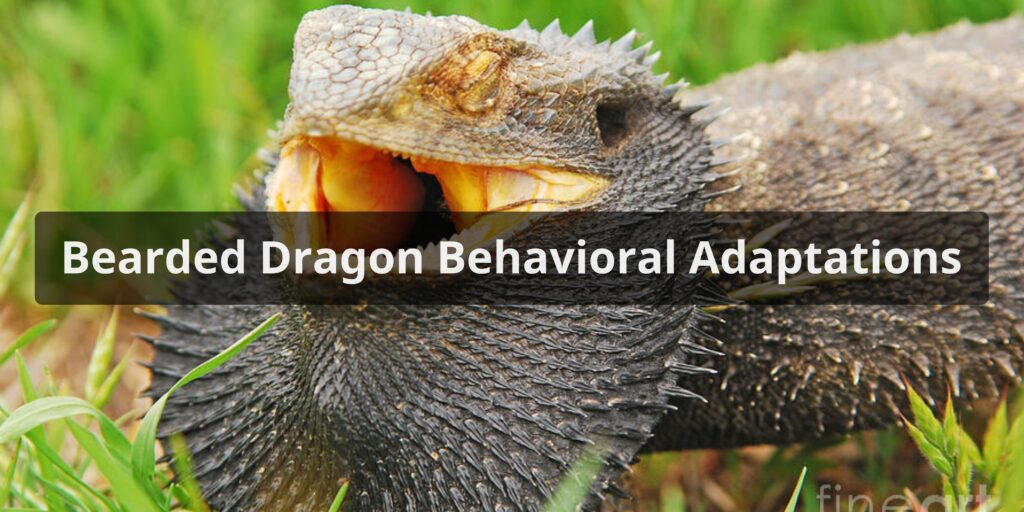Bearded dragons have developed fascinating behavioral adaptations that allow them to thrive in Australia’s harsh desert environment. In this lengthy article, we will explore some of the key ways these reptiles have evolved behaviors to aid their survival.
The bearded dragon (Pogona vitticeps) is a medium-sized lizard that is native to Australia. They live in arid woodlands and deserts across much of the country. To cope with the extremes of their natural habitat, bearded dragon behavioral adaptations. These behaviors help them effectively find food and water, regulate their body temperature, avoid predators, and maximize reproductive success.
Foraging Adaptations

One of the major challenges of living in the desert is finding sufficient food and water. Bearded dragons have developed specialized foraging behaviors to help them meet their nutritional needs.
Sit-And-Wait Hunting
Bearded dragons often adopt a ‘sit-and-wait’ hunting strategy. This involves sitting very still and camouflaged, waiting to ambush passing prey. They have cryptic coloration that allows them to blend into the desert background. When prey comes near, they can launch a rapid strike to grab the animal. This conserves energy and minimizes water loss compared to active hunting.
Wide Diet Breadth
Bearded dragons are opportunistic omnivores. They eat a very wide variety of food including insects, small vertebrates, flowers, and even some fruits. This diverse diet allows them to take advantage of any potential food sources they encounter in their harsh environment. Consuming both plants and animals also provides a balanced nutritional intake.
Rainwater Drinking
Bearded dragons have specialized sensory organs that allow them to detect rain. When it rains, they will emerge from their burrows and stand with their mouths open facing upwards. This allows them to drink falling raindrops efficiently, replenishing their water supplies.
Thermoregulation
Maintaining an optimal body temperature is essential for bearded dragon survival. They use complex behaviors to finely regulate their temperature throughout the day.
Basking Sunning
In the morning, bearded dragons emerge and sit on high perches to bask in the sun. Exposure to direct sunlight raises their body temperature after the cool night. Their dark scales absorb heat efficiently.
Shuttle Behavior
When their body temperature exceeds optimum levels, bearded dragons will shuttle between sun and shade to cool down. Moving into shade lowers their temperature. This shuttle behavior allows precise thermoregulation.
Burrowing
At night or during extreme heat, bearded dragons take shelter in burrows. Burrowing provides insulation from temperature extremes that could cause lethal overheating or freezing.
Predator Avoidance
Bearded dragons use cautionary behaviors to avoid falling prey to the many predators they coexist with.
Cryptic Coloration
Their skin pigments act as camouflage, allowing them to blend into the substrates they live on. This helps conceal them from potential predators.
Freezing Behavior
When threatened, bearded dragons will often freeze completely motionless. This makes them less conspicuous to predators. They may also puff out their throat, which further obscures their body outline.
Burrowing
Taking refuge in burrows helps protect bearded dragons from predation when they are inactive or sleeping. The burrow provides safety and seclusion.
Reproduction Social Behavior
Specific reproductive and social behaviors also facilitate bearded dragon survival in their harsh desert ecosystem.
Courtship Displays
Prior to mating, male bearded dragons will perform courtship behaviors like head-bobbing, arm-waving, and circling females. These displays likely stimulate reproductive receptiveness in females.
Egg-Laying Site Selection
Females carefully choose appropriate egg-laying sites, often deep burrows. This protects the eggs from heat, cold, and predators until hatching.
Communal Nesting
In some populations, female bearded dragons will nest communally and share nest sites. This may improve egg survival rates by distributing predation risk.
Social Tolerance
Bearded dragons are somewhat unusual among lizards in that they are fairly tolerant of each other. This allows them to occupy the same territories without excessive aggression, conserving energy.
Conclusion
In summary, bearded dragons exhibit a diverse array of behavioral adaptations that increase their chances of endurance and reproduction in Australia’s challenging arid environments. Their specialized foraging strategies, thermoregulation tactics, predator avoidance behaviors, and reproductive/social habits all contribute to their ecological success. These complex adaptations highlight the remarkable lengths that reptiles will evolve to thrive in harsh habitats. Careful examination of bearded dragon behavior continues to provide fascinating insights into reptile biology.
FAQs About Bearded Dragon Behavioral Adaptations
What is brumation, and how is it a behavioral adaptation for bearded dragons?
Brumation is a hibernation-like state bearded dragons enter in response to seasonal changes. It conserves energy during cooler months when food is scarce, serving as an adaptation to survive adverse environmental conditions.
Can you explain the role of head bobbing in the behavioral repertoire of bearded dragons?
Head bobbing is a communication tool among bearded dragons. Males use it to display dominance or courtship, while females may head bob to indicate submission or receptivity. It plays a crucial role in social interactions and mating rituals.
How do bearded dragons exhibit territorial behaviors, and why are they important?
Bearded dragons establish territories through head bobbing, beard puffing, and physical displays. These behaviors are essential for resource protection, including access to basking spots, food, and potential mates, contributing to their survival and reproduction.
What is the significance of basking behavior in bearded dragons’ adaptation to their environment?
Basking behavior is critical for thermoregulation. Bearded dragons absorb heat from basking spots to raise their body temperature, aiding digestion and overall metabolism. This adaptation helps them thrive in their arid, desert-like habitats.
How do bearded dragons interact with other members of their species, and what social adaptations do they have?
Bearded dragons engage in both territorial and social interactions. They establish dominance hierarchies through head bobbing and physical displays, and they may form loose social groups. These adaptations help reduce conflicts and maintain group cohesion.
Can you explain the behavioral adaptations of bearded dragons in response to environmental changes or threats?
Bearded dragons adapt to environmental changes by seeking shade or burrowing to escape extreme temperatures. In response to threats, they may puff up their beards, hiss, or change color to deter predators. These adaptations enhance their chances of survival in the wild.



